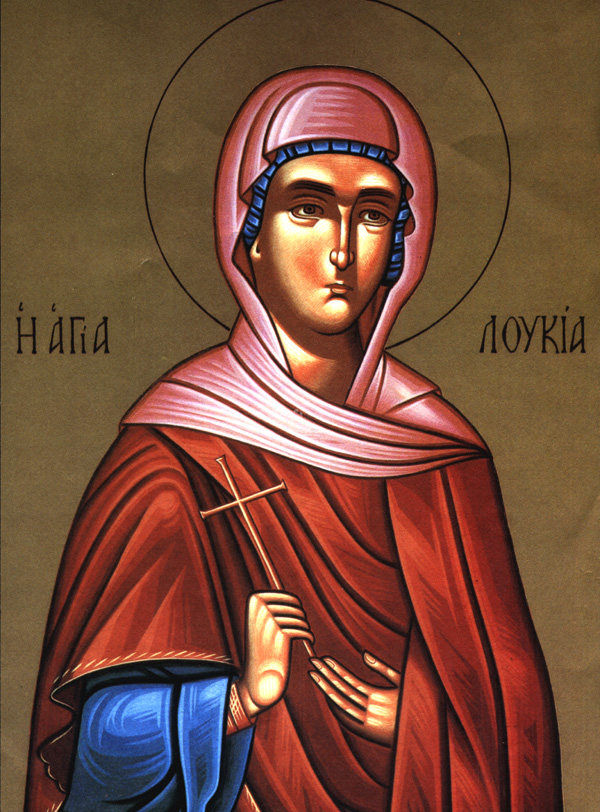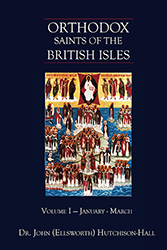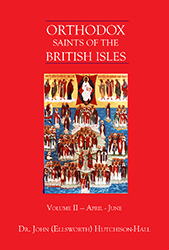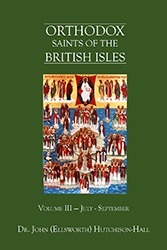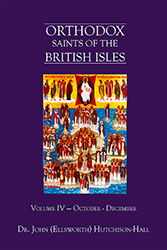
Orthodox Saints of the Pre-Schism
See of Rome
26th December (NS) — 13th December (OS) 2023
ANTIOCHUS, a martyr for whom the town and island of Sant'Antioco in Sardina are named. St. Antiochus was apparently a travelling physician and evangelist, arrested during the reign of the Emperor Hadrian (r. 117–138). He was sentenced to forced labour on the island of Sulci, now Sant'Antioco, and eventually beaten to death as an example for the other prisoners.
AUTBERT, a (possibly the seventh) Bishop of Cambrai-Arras (northern France) in late seventh century St. Aubert had received monastic tonsure at the Abbey of SS. Peter and Paul of Luxeuil (abbaye Saint-Pierre et Saint-Paul de Luxeuil), and prior to episcopal consecration founded the Abbey of St. Vaast in Arras, Pas-de-Calais.
EDBURGH (EDBURGA), a seventh century nun at Lyminge in Kent, England. Nothing further is known of her life.
EDBURGH (EDBURGA) of THANET, the only daughter of King Centwine and Queen Engyth of Wessex. She received Monastic Tonsure at Minster-in-Thanet and became a disciple of St. Mildred of Thanet (13th July), whom she succeeded as Abbess in 716, ruling Minster-in-Thanet until her repose in 751.
EINHILD (EINHILDIS) and ROSWINDA, (Eighth Century), nuns at Hohenburg Abbey in Alsace. St. Einhild went on to serve as Abbess of Niedermünster near Hohenburg. St. Roswinda, was St. Odilia’s (vide infra) sister, who was also at Hohenburg Abbey.
JUDOCUS (JUDDOC, JOSSE, JOOST), a member of the Bretton nobility, and either the son or brother of King St. Judicäel of Brittany (17th December). Following a pilgrimage to Rome, St. Judocus renounced his title, was ordained to the priesthood, and then spent the rest of his life as a hermit where the commune of Saint-Josse-sur-Mer, Pas-de-Calais, France is located today. St. Judocus reposed circa 668.
LUCY of SYRACUSE, a young Christian maiden whose mother had betrothed her to a pagan man. When St. Lucy rejected her bridegroom, he denounced her to the governor of Sicily who had her arrested. St. Lucy was subjected to torture which included her eyes being gouged out, she was then surrounded by wood which was set alight, however, the fire extinguished itself, and she was stabbed to death.
Troparion of St. Lucy of Syracuse — Tone V
Wearing the radiant cloak of virginity
And being betrothed to the Lifegiver Christ
You forsook the love of your earthly betrothed
O Lucy Virgin-Martyr
Therefore as a bridal gift
You have brought to Christ the outpouring of your blood
You also intercede to Him for us all!
ODILIA (OTILIA, OTHILIA), said to have been born blind and rejected by her noble family, St. Odilia was adopted by a monastery where tradition says her sight was restored as she received the sacrament of baptism. St. Odilia was the foundress of Hohenburg Abbey, where she was later joined by her sister, St. Roswinda (vide supra). St. Odilia reposed circa 720.
TASSIO, a Bavarian duke, and founder and endower of many monasteries and churches. St. Tassio retired to live his later life as a monk at Jumièges Abbey in Normandy, and reposed circa 794.
WIFRED, a monk and later Abbot of the Abbey of St. Victor of Marseilles.
St. Wifred reposed in 1021.
AMAETHLU (MAETHLU), a sixth century Welsh saint for whom the church and village of Llanfaethlu in Anglesey is named. Nothing further is known about his life.
DIONYSIUS, twenty-fifth Pope of Rome, assuming the throne in 259 following a one year interregnum caused by the Valerian Persecution (257–260). As Pope, St. Dionysius opposed Sabellius and condemned Paul of Samosata’s heretical writings. St. Dionysius reposed in 268, the first Pope of Rome not to have been martyred.
MARINUS, the son of an Imperial Roman Senator, and possibly a senator himself. Tortured and martyred for being a Christian in 283.
TATHAI (TATHAN, TATHAEUS, ATHAEUS), an Irish monk or hermit who, in the late fifth or early sixth century lived in an area that was called Llantathan in Glamorgan, Wales, after him. He is said to have founded a monastery there, which at the time, was quite well known. Some sources state that St. Tathai founded another monastic school in Gwent where St. Cadoc (24th January) is said to have been a student.
THEODORE the SACRIST, (Sixth Century), a sacristan at St. Peter’s Basilica in Rome. The limited information on his life comes from the writings of his contemporary of St. Gregory the Dialogist (3rd September).
ZOSIMUS, elected forty-first Pope of Rome in March 417, St. Zosimus spent a great deal of his papacy advancing the cause of Papal Supremacy. He fought against Pelagianism, even engaging Pelagius himself. St. Zosimus reposed in December 418.
Prior to the Schism the Patriarchate of Rome was Orthodox, and fully in communion with the Orthodox Church. As Saint John of Shanghai and San Francisco +1966 said “The West was Orthodox for a thousand years, and her venerable Liturgy is far older than any of her heresies”.
Details of British Saints excerpted from Orthodox Saints of the British Isles.
Details of continental saints from these sources.
In many cases there are several spelling versions of the names of saints from the British Isles. I use the Oxford Dictionary of National Biography version as the primary version with the more prevalent version in parenthesis e.g. Ceadda (Chad) of Lichfield.
